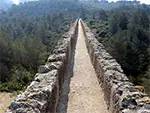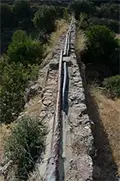Roman Aqueducts
The Romans built aqueducts to keep their supply of fresh water adequate. The aqueducts brought water into Rome and other cities from faraway places, such as mountain rivers and reservoirs. The idea behind the construction of an aqueduct was to let gravity do its thing, pulling the fresh water downhill toward its destination. In Rome and in other cities, aqueducts fed cisterns, which supplied public baths, fountains, houses, and latrines with fresh water; other pipes took waste water away. Some aqueducts supplied agricultural or other business needs as well. Some mills got their power from aqueduct water. 
The Romans were careful to build the conduits at a slight downward grade. They made these conduits from brick, concrete, or stone. All materials were cut to fit Those conduits were part of a water movement system that also included sedimentation tanks, for removing waste from the water before it got to its destination. 
That aqueduct was one of eventually 11 that fed the needs of Rome's large population. The people of Rome in the early days got by on the various springs that dotted the landscape, but the water from the River Tiber was notoriously nonpotable and the population soon outgrew the capacity of the local water supply. Thus were the aqueducts built. Despite the picturesque nature of the arched aqueducts that are the focus of so many photographs, most of Rome's piped waterways were underground. The first one built, the Aqua Appia in 312 B.C., was nearly all underground. of the nearly 500 miles of aqueducts that serviced Rome, only 29 miles of those were above ground. Some of those arched aqueducts were long and spectacular to look at; they also served as road bridges across otherwise difficult terrain. The Romans built the system to be maintained, installing methods of diverting the water and repairing the pipes. Access points allowed periodic maintenance checks. The pipes were made of mainly terracotta, lead, stone, and clay. The longest aqueduct in Roman lands was the Anio Novus, which covered the 87 miles from the Aniene River to Rome. It took workers 14 years to build. It wasn't just in Italy that the Romans built aqueducts. They were standard operating procedure when the Romans took over a city or people Julius Caesar had one built to service Antioch; this was the first aqueduct built outside Italy. The last Roman aqueduct, the Aqua Alexandrina, was built in 226. It was one of the 10 aqueducts supplying Rome that the invading Germanic tribes vandalized in their invasions in the last days of the Western Roman Empire. In the end, it was only the Aqua Virgo, which was completely underground, that was still supplying Rome with water. |
|
Social Studies for Kids
copyright 2002–2024
David White



 snugly together. As with the
snugly together. As with the 

